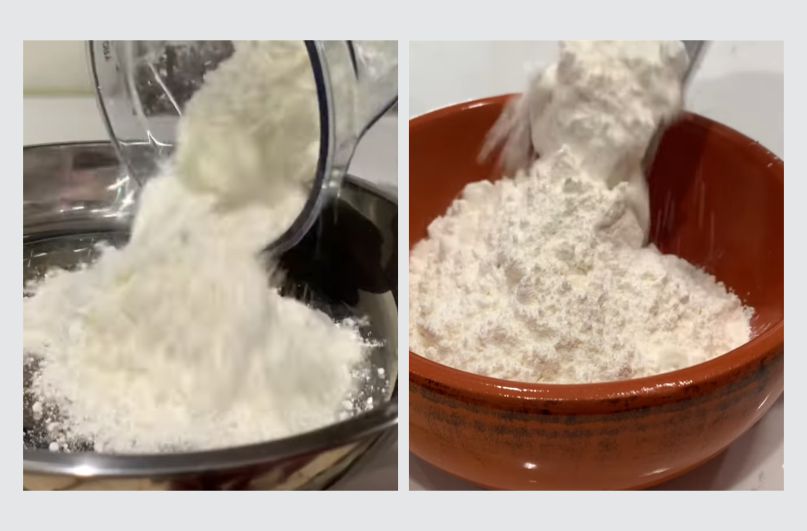Cassava flour and arrowroot powder work differently in cooking and baking. Learn their textures, benefits, and best uses to pick the right one for your needs.
If you’re deciding between cassava flour and arrowroot powder, knowing their differences can help you cook with confidence.
Both come from plant roots, but they serve different purposes. Cassava flour is made from the whole cassava plant root, giving it a mild flavor and fiber-rich texture, perfect for baking.
Arrowroot, processed into a fine starch, is flavorless and works well as a thickener in soups, sauces, and desserts.
Whether you need a sturdy flour for bread or a smooth thickener for gravies, this guide will help you choose the right one for your next recipe. Let’s explore their best uses.
Related: Cassava Flour vs Chickpea Flour
Table of Contents
- An Overview of Cassava Flour and Arrowroot
- Cassava Flour vs Arrowroot: Key Differences
- Texture and Baking Properties: Cassava Flour vs Arrowroot
- Which One Should You Choose?
- Cassava Flour vs Arrowroot: Health and Nutrition Guide
- Conclusion
An Overview of Cassava Flour and Arrowroot
What is Cassava Flour?
Cassava flour comes from the whole root of the cassava plant, a tropical shrub native to South America.
The root is peeled, dried, and ground into a fine powder, creating a gluten-free flour that works well in various recipes.
It has a mild flavor, making it an easy substitute for wheat flour in baked goods, sauces, and soups.
Nutritionally, cassava flour is rich in carbohydrates and contains some vitamins and minerals, including Vitamin C and folate.
While low in protein and fiber, it serves as a great option for gluten-free diets and grain-free baking.
What is Arrowroot?
Arrowroot is a starch extracted from the rhizomes of tropical plants, mainly Maranta arundinacea.
Native to the Caribbean and South America, it has been used for centuries as a thickening agent in cooking.
The rhizomes are washed, grated, and processed into a fine, white, gluten-free powder.
Arrowroot is valued for its neutral taste and ability to create a smooth, clear consistency in sauces, soups, and gravies.
Unlike cassava flour, it contains no fiber, making it ideal for delicate dishes where a light texture is desired. It’s also easy to digest.
Related: Cassava Flour vs Wheat Flour
Cassava Flour vs Arrowroot: Key Differences
Choosing between cassava flour and arrowroot depends on what you’re making and your dietary needs.
Both are gluten-free and come from plant roots, but their textures, flavors, and uses vary.
Cassava flour is made from the whole cassava root, giving it more fiber and a slightly nutty taste.
It works well in baking, adding moisture and chewiness to bread, pancakes, and pastries.
However, its high glycemic index may not be ideal if you’re watching your blood sugar.
Arrowroot comes from the rhizomes of the arrowroot plant. It’s mostly starch, has no fiber, and blends smoothly into sauces, soups, and gravies. It’s also great for frying, creating a crispy coating.
Cassava flour is best for baking, while arrowroot excels as a thickener and frying ingredient. Knowing how they differ helps you pick the right one for your recipes.
Related: Cassava Flour vs Tapioca Flour
Cassava Flour vs Arrowroot: Key Differences
| Feature | Cassava Flour | Arrowroot Flour |
|---|---|---|
| Source | Whole cassava root (Manihot esculenta) | Rhizomes of the arrowroot plant (Maranta arundinacea) |
| Processing | Peeled, dried, and ground into a fine powder | Starch extracted, dried, and ground into powder |
| Texture | Slightly grainy, fine powder | Silky smooth, very fine powder |
| Flavor | Mildly nutty | Neutral |
| Uses | Baking (bread, pancakes, pastries), thickening soups and sauces | Thickening soups, sauces, and gravies; frying batter |
| Nutritional Content | Higher fiber, contains some vitamins and minerals | Mostly starch, low in fiber and nutrients |
| Glycemic Index | High (may impact blood sugar levels) | Low (better for blood sugar control) |
| Best For | Baking, adding chewiness and moisture to foods | Thickening, frying, creating a crispy texture |
Further Reading: Cassava Flour vs Coconut Flour
Texture and Baking Properties: Cassava Flour vs Arrowroot
Choosing between cassava flour and arrowroot depends on the texture and consistency you want in your recipe. Both are gluten-free but behave differently in baking.
Cassava Flour: Dense and Chewy
Cassava flour absorbs moisture well, giving baked goods a denser, chewier feel. This makes it great for bread, muffins, and pancakes that need structure.
Its mild flavor blends easily with other ingredients, making it a flexible choice for gluten-free baking.
Arrowroot Flour: Light and Smooth
Arrowroot creates softer, more delicate textures in baked goods like cookies and cakes.
Unlike cassava flour, it doesn’t add density, making it a good option for lighter pastries. Arrowroot is also excellent for thickening sauces and puddings, adding a smooth, silky consistency without affecting flavor.
Which One to Use?
- For chewy, hearty baked goods → Use cassava flour.
- For light, delicate textures → Choose arrowroot flour.
- For thickening sauces and soups → Arrowroot flour works best.
Here’s a clear table comparing the texture and baking properties of cassava flour and arrowroot:
| Property | Cassava Flour | Arrowroot Flour |
|---|---|---|
| Source | Whole cassava root | Rhizomes of the arrowroot plant |
| Texture | Slightly coarse | Very fine and smooth |
| Moisture Absorption | High (creates a dense texture) | Low (keeps baked goods light) |
| Best For Baking | Bread, muffins, pancakes (chewy and hearty) | Cookies, cakes (soft and delicate) |
| Thickening Ability | Moderate | Excellent (silky, smooth consistency) |
| Flavor | Mild, slightly nutty | Neutral, blends easily |
| Best Uses | Gluten-free baking, dense recipes | Thickening sauces, light pastries |
Related: Recipe for Cassava Flour Pancakes
Which One Should You Choose?
Deciding between cassava flour and arrowroot depends on what you’re cooking and your dietary needs.
Each flour has unique qualities that make it better suited for specific recipes.
Cassava Flour: Best for Baking and Structure
Cassava flour comes from the whole cassava root, giving it a mild, slightly sweet flavor. It’s rich in carbohydrates and contains fiber, making it a popular choice for gluten-free and grain-free diets.
If you’re making bread, pancakes, or muffins, cassava flour adds structure and chewiness to your baked goods.
Arrowroot: Best for Thickening and Light Textures
It’s mostly starch and works well as a thickener in soups, sauces, and gravies. When used in baking, arrowroot keeps pastries light and crisp, making it ideal for cookies and delicate cakes.
How to Choose the Right One
- Need a chewy, hearty texture? Go with cassava flour.
- Want a smooth, silky consistency? Arrowroot is your best bet.
- Looking for fiber? Cassava flour has more.
- Making a sauce or soup? Arrowroot thickens without altering flavor.
Here’s a clear and concise table comparing cassava flour and arrowroot to help you choose the right one for your recipe:
| Feature | Cassava Flour | Arrowroot Flour |
|---|---|---|
| Source | Whole cassava root | Maranta arundinacea rhizomes |
| Texture | Slightly coarse | Fine and silky |
| Flavor | Mild, slightly sweet | Neutral |
| Best Use | Baking (bread, pancakes, muffins) | Thickening sauces, soups, gravies |
| Structure | Adds chewiness and density | Creates light, crisp textures |
| Nutritional Content | Higher fiber and carbs | Mostly starch, low in fiber |
| Thickening Ability | Moderate | Stronger thickening power |
| Gluten-Free? | Yes | Yes |
| Ideal For | Hearty baked goods | Light pastries and coatings |
| Substitutions | Can replace wheat flour in some recipes | Works as a thickener and lightener in flour blends |
Related: Cassava Flour Recipes
Cassava Flour vs Arrowroot: Health and Nutrition Guide
If you’re looking for gluten-free, grain-free flour alternatives, you’ve probably come across cassava flour and arrowroot powder. They might seem similar, but their nutrition and health benefits differ. Knowing the differences can help you choose what fits your diet best.
Nutritional Breakdown
Cassava Flour
Made from the whole cassava root, cassava flour is high in fiber and complex carbohydrates. Here’s what 100 grams provides:
- Calories: ~330 kcal
- Carbohydrates: ~78g
- Fiber: ~6g
- Protein: ~2g
- Fat: ~0.5g
Cassava flour supports digestion and gut health due to its fiber and resistant starch, which may improve insulin sensitivity and feed good bacteria in your gut.
Arrowroot Powder
Arrowroot powder, also called arrowroot starch, is extracted from the arrowroot plant’s rhizomes. Unlike cassava flour, it’s refined to remove fiber. A 100-gram serving contains:
- Calories: ~357 kcal
- Carbohydrates: ~88g
- Fiber: ~0.5g
- Protein: ~0.2g
- Fat: ~0.1g
Since arrowroot is nearly pure starch, it digests easily, making it a good choice for sensitive stomachs. It’s commonly used as a thickener in cooking.
Health Considerations
Digestive Health
Cassava flour’s fiber helps with regular digestion and nourishes gut bacteria. Arrowroot, being low in fiber, is gentler on digestion and can help during digestive issues like diarrhea.
Blood Sugar Levels
Cassava flour has a lower glycemic impact due to its fiber and resistant starch, which may help manage blood sugar. Arrowroot, as a refined starch, digests quickly and may cause blood sugar spikes.
Food Sensitivities
Both cassava flour and arrowroot powder are gluten-free, grain-free, and nut-free, making them safe for many diets. Arrowroot is especially gentle for those with food sensitivities or digestive issues.
Here’s a tabulated comparison of cassava flour and arrowroot powder based on health and nutrition:
| Feature | Cassava Flour | Arrowroot Powder |
|---|---|---|
| Source | Whole cassava root | Arrowroot rhizomes |
| Processing | Minimally processed, retains fiber | Refined, fiber removed |
| Calories (per 100g) | ~330 kcal | ~357 kcal |
| Carbohydrates | ~78g | ~88g |
| Fiber | ~6g | ~0.5g |
| Protein | ~2g | ~0.2g |
| Fat | ~0.5g | ~0.1g |
| Digestive Health | Supports gut bacteria, aids digestion | Gentle on digestion, helps with diarrhea |
| Blood Sugar Impact | Lower glycemic impact due to fiber and resistant starch | High glycemic index, may cause spikes |
| Best Uses | Baking, gluten-free recipes | Thickening soups, sauces, and desserts |
| Dietary Suitability | Gluten-free, grain-free, nut-free | Gluten-free, grain-free, nut-free |
Conclusion
In the cassava flour vs arrowroot comparison, we have seen that both have unique roles in the kitchen. Cassava flour adds structure and chewiness to baked goods, while arrowroot powder creates a light, smooth consistency in sauces and pastries.
Choosing between them depends on your cooking needs, whether it’s baking hearty bread or thickening a delicate sauce.
Understanding their differences helps you make informed choices for gluten-free and grain-free cooking.
Experiment with both to see which works best for your favorite recipes!

Chimeremeze Emeh is a writer and researcher passionate about Africa’s most transformative root crop—cassava. Through his work at cassavavaluechain.com, he explores the entire cassava industry, from cultivation and processing to its diverse applications in food, health, and industrial use.
He also writes for palmoilpalm.com, where he shares his extensive experience and deep-rooted knowledge of palm oil, covering red palm oil, palm kernel oil, and refined products. His work there reflects his lifelong connection to agriculture and his commitment to promoting sustainable value chains in Africa.
Driven by curiosity and purpose, Chimeremeze aims to shed light on how cassava continues to empower communities, strengthen food systems, and link traditional farming wisdom with modern innovation.

